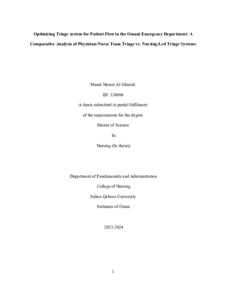Document
Optimizing triage system for patient flow in the Omani Emergency Department : a comparative analysis of Physician-Nurse Team Triage vs. Nursing-Led Triage Systems.
Source
Master's thesis
Other titles
تحسين نظام الفرزالأولي للمرضى في قسم الطوارئ في عمان : تحليل مقارن بين نظام الفرزالأولي للفريق الطبي المكون من طبيب وممرض ونظام الفرز الأولي لفريق التمريض
Country
Oman
City
Muscat
Publisher
Sultan Qaboos University
Gregorian
2024
Language
English
Thesis Type
Master's thesis
English abstract
Background: Overcrowding in the emergency department (ED) delays treatment and can
negatively affect patient outcomes. Introducing and modifying the current system to overcome
overcrowding is crucial for improving patient outcome.
Purpose: This study compared efficiency and quality measures between two models: the
physician-nurse team triage model and nursing-only led triage in the ED.
Methods: A retrospective comparison of two study periods was made, each utilizing a different
triage model: nurse-led triage in 2015 and physician-nurse team triage in 2018. The following data
were gathered from electronic medical charts and the National Mortality Registry: waiting time,
time to physician, return visits to the ED within 48 hours, time to disposition, time to radiology,
and various diagnostic test turnaround times (Complete Blood Count (CBC), Aerobic Blood
Culture (ABC), Anaerobic Blood Culture (ANBC), Thyroid Function Test (TFT), and troponin).
Result: Our analysis revealed that the mean length of stay, time to discharge, average time to
ABC, time taken for patients to be seen by a physician, and other factors decreased significantly
in the physician-led team system compared to the nurse-only led group.
Conclusion: The transition from a nurse-led to a physician-nurse team triage model demonstrated
enhanced patient flow and decreased overcrowding. As expected, greater collaboration between health team members always leads to more positive health outcomes. It provides comprehensive care as different professionals bring diverse expertise and perspectives, ensuring that all aspects of a patient's health are addressed. Moreover, it enhances Patient Satisfaction as patients benefit from a more coordinated approach to their care, leading to better experiences and outcomes. Finally, working together encourages the sharing of ideas and best practices, which leads to innovative solutions and improvements in patient care.
Arabic abstract
المقدمة: يمكن أن يؤثر إزدحام المرضى في قسم الطوارئ بشكل سلبي على نتائج المرضى، ولذلك تعد مراجعة نظام الطوارئ الحالي وتعديله للتغلب على الاكتظاظ أمًرا بالغ الاهمية لتحسين الاداء. هدف الدراسة : تهدف الدواسة إلى مقارنة الاداء والكفاءة بين نظامين للفرز الاولي للمرضى في قسم الطوارئ : نظام الفرز الاولي للفريق الطبي المكون من طبيب وممرض و نظام الفرز الاولي لفريق التمريض. التصميم وطرق العمل: تم القيام بمقارنة رجعية لفترتين دراسيتين، كل فترة تستخدم نموذج فرز مختلف: الفرز بقيادة التمريض في عام 2015 )الاساس( ونظام فرز الفريق الطبي المكون من طبيب وممرض في عام 2018 )التدخل(. تم جمع البيانات التالية من السجالت الطبية الالكترونية والسجل الوطني للوفيات: عدد الزيارات المتكررة لقسم الطوارئ خالل 48 ساعة من الزيارة الاولى ، فترة بقاء المريض في قسم الطوارئ، الوقت اللازم لوصول عينات الدم، الوقت اللازم إلجراء فحوصات الاشعة، والوقت اللازم لنتائج الفحوصات. النتائج: أظهر تحليل الدراسة أن متوسط مدة البقاء في الطوارى، ووقت الخروج من الطوارى، ومتوسط الوقت للوصول إلى الطبيب ، والوقت المستغرق لرؤية المرضى من قبل الطبيب، الوقت اللازم لوصول عينات الدم، الوقت اللازم إلجراء فحوصات الاشعة، بالمجموعة التي يقودها والوقت اللازم لنتائج الفحوصات قد انخفضت بشكل كبير في نظام الفريق بقيادة الطبيب والممرض مقارنةً الممرض فقط . الخالصة: أظهرت الدراسة أن الانتقال من نظام الفرز بقيادة التمريض إلى نظام فرز الفريق الطبي المكون من طبيب وممرض أدى إلى تحسن كبير في مؤشرات الاداء الرئيسية، مما يثبت تفوق نظام فرز الفريق الطبي في تعزيز كفاءة وجودة الرعاية الصحية للمرضى. يجب أن تركز الدراسات المستقبلية في استكشاف الفوائد طويلة الاجل والامكانية لتطبيق هذا النموذج للفرز على نطاق أوسع في بيئات الرعاية الصحية المختلفة.
Category
Theses and Dissertations

